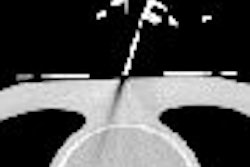
NEW YORK (Reuters Health), Sep 19 - While CT, unlike MRI, involves the use of radiation and intravenous contrast agents, it is more accurate in detecting coronary artery disease (CAD), according to a report in the Annals of Internal Medicine for September 19.
"The high negative predictive value of multislice CT for the presence of coronary artery stenoses (95%) makes it potentially useful as a diagnostic tool for ruling out coronary artery disease in a population with a low to intermediate pretest likelihood," lead author Dr. Marc Dewey, from Humboldt-Universitat zu Berlin, and colleagues note.
Cardiac catheterization with angiography is the reference standard for diagnosing CAD. While useful if an interventional procedure is required, recent reports suggest that the majority of angiographies are performed solely for diagnostic purposes. Multislice CT and MRI have been proposed as noninvasive, cost-effective alternatives to catheterization for diagnosing CAD.
Previous reports have suggest that multislice CT is superior to MRI in diagnosing coronary artery disease, the authors note. However, it is important to confirm this finding given the radiation and contrast risks associated with CT, they add.
The present study involved 129 consecutive patients who were evaluated at a tertiary referral center in Berlin for suspected coronary artery disease. The analysis focused on 108 patients who had 430 vessels examined with both multislice CT and MRI before undergoing conventional angiography.
In the per-patient analysis, multislice CT was 92% sensitive in diagnosing CAD compared with a value of 74% for MRI (p = 0.013). The difference in sensitivities was even more pronounced regarding clinically significant stenoses: 82% versus 54%, respectively (p < 0.001).
In the per-vessel analysis, multislice CT had a specificity of 90% and a negative predictive value of 95% in diagnosing CAD. The corresponding values for MRI were lower: 87% and 90%.
Analysis of the radiation dose used during CT indicated that it was on par with that used during diagnostic cardiac catheterization.
When surveyed, 74% of patients indicated a preference for CT over MRI for future diagnostic imaging, the report indicates.
"Clinicians should not use multislice CT routinely in the evaluation of patients with suspected myocardial ischemia," Dr. Philip Greenland, from Northwestern University in Chicago, states in a related editorial. "Multislice CT is not useful in patients with a high pretest probability of CAD and may be harmful."
However, he adds that the test "is useful when the diagnosis is uncertain after a careful chest pain history and equivocal results on functional testing for CAD."
Ann Intern Med 2006;145:407-415,466-467.
Last Updated: 2006-09-18 19:39:14 -0400 (Reuters Health)
Related Reading
Lifetime cost of CAD for women often exceeds $1 million, August 22, 2006
Copyright © 2006 Reuters Limited. All rights reserved. Republication or redistribution of Reuters content, including by framing or similar means, is expressly prohibited without the prior written consent of Reuters. Reuters shall not be liable for any errors or delays in the content, or for any actions taken in reliance thereon. Reuters and the Reuters sphere logo are registered trademarks and trademarks of the Reuters group of companies around the world.

















